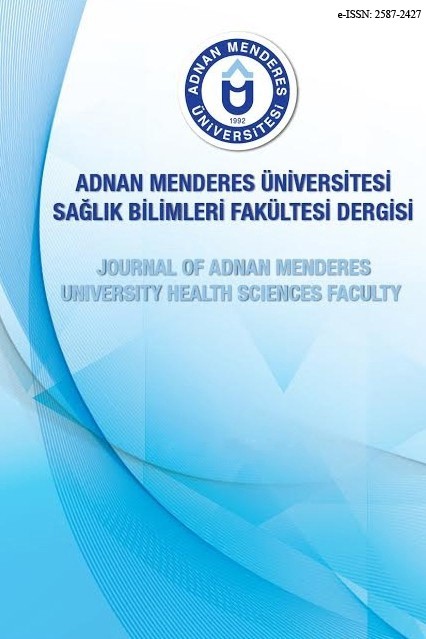Ht-29 Hücrelerinde 5-ALA Kullanılarak Tümör Floresan Görüntüleme Yöntemi
5-aminolevulinik asit (ALA), Floresans görüntüleme, Tümör hücreleri, Apoptoz, Fotodinamik Tanı
Tumor Florescence Imaging Method Using 5-ALA in Ht-29 Cells
5-aminolevulinic acid (ALA), Florescence Imaging, Tumor cells, Apoptosis, Photodynamic Diagnosis,
___
- 1. Knowlton, C. A., Mackay, M. K., Speer, T. W., Vera, R. B., Arthur, D. W., Wazer, D. E.et al. (2022). Colon Cancer. Encyclopedia of Radiation Oncology, 77–77.
- 2. Kitada, M., Ohsaki, Y., Matsuda, Y., Hayashi, S., & Ishibashi, K. (2015). Photodynamic diagnosis of pleural malignant lesions with a combination of 5-aminolevulinic acid and intrinsic fluorescence observation systems. BMC Cancer, 15(1).
- 3. Kausch, I., Sommerauer, M., Montorsi, F., Stenzl, A., Jacqmin, D., Jichlinski, P., et al. (2010). Photodynamic diagnosis in non-muscle-invasive bladder cancer: a systematic review and cumulative analysis of prospective studies. European Urology, 57(4), 595–606.
- 4. Kobuchi, H., Moriya, K., Ogino, T., Fujita, H., Inoue, K., Shuin, T., et al. (2012). Mitochondrial localization of ABC transporter ABCG2 and its function in 5-aminolevulinic acid-mediated protoporphyrin IX accumulation. PloS One, 7(11).
- 5. Kenan, S., Liang, H., Goodman, H. J., Jacobs, A. J., Chan, A., Grande, D. A., et al. (2020). 5-Aminolevulinic acid tumor paint and photodynamic therapy for myxofibrosarcoma: an in vitro study. Journal of Orthopaedic Surgery and Research, 15(1).
- 6. Koizumi, N., Harada, Y., Minamikawa, T., Tanaka, H., Otsuji, E., Takamatsu, T. (2016). Recent advances in photodynamic diagnosis of gastric cancer using 5-aminolevulinic acid. World Journal of Gastroenterology, 22(3), 1289–1296.
- 7. Inoue, Y., Tanaka, R., Komeda, K., Hirokawa, F., Hayashi, M., Uchiyama, K. (2014). Fluorescence detection of malignant liver tumors using 5-aminolevulinic acid-mediated photodynamic diagnosis: principles, technique, and clinical experience. World Journal of Surgery, 38(7), 1786–1794.
- 8. Nishimura, M., Murayama, Y., Harada, K., Kamada, Y., Morimura, R., Ikoma, H., et al. (2016). Photodynamic Diagnosis of Hepatocellular Carcinoma Using 5-Aminolevulinic Acid. Anticancer Research, 36(9), 4569– 4574.
- 9. Nokes, B., Apel, M., Jones, C., Brown, G., Lang, J. E. (2013). Aminolevulinic acid (ALA): photodynamic detection and potential therapeutic applications. The Journal of Surgical Research, 181(2), 262–271.
- 10. Fukuhara, H., Yamamoto, S., Karashima, T., Inoue, K. (2021). Photodynamic diagnosis and therapy for urothelial carcinoma and prostate cancer: new imaging technology and therapy. International Journal of Clinical Oncology, 26(1), 18–25.
- 11. Brunner, H., Hausmann, F., Knuechel, R. (2003). New 5-aminolevulinic acid esters--efficient protoporphyrin precursors for photodetection and photodynamic therapy. Photochemistry and Photobiology, 78(5), 481.
- 12. Casas, A. (2020). Clinical uses of 5-aminolaevulinic acid in photodynamic treatment and photodetection of cancer: A review. Cancer Letters, 490, 165–173.
- 13. Ramonaite, R., Petrolis, R., Unay, S., Kiudelis, G., Skieceviciene, J., Kupcinskas, L., et al. (2019). Mathematical morphology-based imaging of gastrointestinal cancer cell motility and 5-aminolevulinic acid-induced fluorescence. Biomedizinische Technik. Biomedical Engineering, 64(6).
- 14. Kenan, S., Liang, H., Goodman, H. J., Jacobs, A. J., Chan, A., Grande, D. A., et al. (2020). 5-Aminolevulinic acid tumor paint and photodynamic therapy for myxofibrosarcoma: an in vitro study. Journal Of Orthopaedic Surgery and Research, 15(1), 94.
- 15. Srikoon, P., Chaemsawang, W., Phimsen, S., Vaeteewoottacharn, K., Khongkaew, P., Chamsawang, W. (2021). Deoxycholic acid-formulated curcumin enhances caspase 3/7-dependent apoptotic induction in cholangiocarcinoma cell lines. Journal of Basic and Applied Pharmacology, 1(1).1-9.
- 16. Hirano, T., Hagiya, Y., Fukuhara, H., Inoue, K., Shuin, T., Matsumoto, K., et al. (2013). Improvement of aminolevulinic acid (ALA)-mediated photodynamic diagnosis using n-propyl gallate. Photodiagnosis and Photodynamic Therapy, 10(1), 28–32.
- 17. Nakanishi, T., Ogawa, T., Yanagihara, C., Tamai, I. (2015). Kinetic Evaluation of Determinant Factors for Cellular Accumulation of Protoporphyrin IX Induced by External 5-Aminolevulinic Acid for Photodynamic Cancer Therapy. Journal of Pharmaceutical Sciences, 104(9), 3092–3100.
- 18. Kitajima, Y., Ishii, T., Kohda, T., Ishizuka, M., Yamazaki, K., Nishimura, Y., et al. (2019). Mechanistic study of PpIX accumulation using the JFCR39 cell panel revealed a role for dynamin 2-mediated exocytosis. Scientific Reports, 9(1).
- 19. Kawczyk-Krupka, A., Latos, W., Latos, M., Czuba, Z. P., Sieroń, A. (2016). ALA-induced photodynamic effect on viability, apoptosis, and secretion of S100 protein, secreted by colon cancer cells in vitro. Photodiagnosis and Photodynamic Therapy, 15, 218–227.
- 20. Jones, P. S., Yekula, A., Lansbury, E., Small, J. L., Ayinon, C., Mordecai, S., et al. (2019). Characterization of plasma-derived protoporphyrin-IX-positive extracellular vesicles following 5-ALA use in patients with malignant glioma. EBioMedicine, 48, 23–35.
- 21. Kushibiki, T., Noji, T., Ebihara, Y., Hontani, K., Ono, M., Kuwabara, S., et al. (2017). 5-Aminolevulinic-acid- mediated Photodynamic Diagnosis Enhances the Detection of Peritoneal Metastases in Biliary Tract Cancer in Mice. In Vivo (Athens, Greece), 31(5), 905–908.
- 22. 2Ito, H., Kurokawa, H., Suzuki, H., Indo, H. P., Majima, H. J., Matsui, H. (2019). 5-Aminolevulinic acid induced apoptosis via oxidative stress in normal gastric epithelial cells. Journal of Clinical Biochemistry and Nutrition, 65(2), 83–90.
- Yayın Aralığı: Yılda 3 Sayı
- Başlangıç: 2017
- Yayıncı: Aydın Adnan Menderes Üniversitesi
Pandemide Gençlerde Kronotip ve Hedonik Açlık ile Yaşam Tarzı ve Beslenme Durumu İlişkisi
Gökçe Sueda AYDOĞDU, Eda KÖKSAL
Kanserli Hastada Sarkopeni’ye Güncel Bakış
Planlı Eğitimin Epilepsili Çocuklarda Yaşam ve Uyku Kalitesine Etkisi
Selin DEMİRBAĞ, Dilek ERGİN, Muzaffer POLAT
Hemşirelik Öğrencilerinin Sağlık Bakımında Bilgisayar Kullanımına Yönelik Tutumlarının İncelenmesi
Özlem ALTINBAŞ AKKAŞ, Ayşegül AÇIL, Feyza DEMİR BOZKURT, Fatma EKER
Düzeltme: Gençlerde Nörolojik Hastalıklarda Farkındalık; Multiple Skleroz
Gamze TEMİZ, Semiha AKIN, Büşra EKER, Elif KOÇ, Esmanur ÇİVİOĞLU, Özgür ARGIN, Gülsüm ATICI, Serkan DAĞDELEN, Semanur ÇOBAN
Bertan AKAR, Emre KÖLE, Deniz SÜNNETÇİ AKKOYUNLU, Merve ÇAKIR KÖLE, Naci ÇİNE, Hakan SAVLI, Eray ÇALIŞKAN
Obezitenin Hastalık Sürecinde Yaşam Kalitesine Etkisi: COVID-19 Örneği
Şizofreni Hastalarının Primer Bakım Vericilerinin Yük ve Tükenmişliğini Etkileyen Faktörler
Kadınların Doğum Sırasındaki Mahremiyet ile İlgili Deneyim, Görüş ve Önerileri
